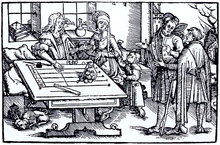Calculating on lines

The computing on lines is a historic computational method for basic arithmetic . Numbers are laid out with arithmetic pennies or calculi , changed and read as the result. The arithmetic pennies are positioned on or between horizontal lines. Depending on the position of a computing penny, it is assigned a certain value. Calculating on lines was the most common calculation method in the Middle Ages. It was used by traders and merchants. The abstract written arithmetic invented in India was still uncommon in Europe at that time.
If the lines in a panel (z. B. made of cardboard, wood or metal) cut, is movable pins or buttons so that can be moved, so one speaks of an abacus , Rechenknecht , computing arc or calculation table . The Romans called the device an abacus .
When calculating on lines, parallel horizontal lines are drawn or scratched on a cloth, table, board or bench. The lines are used to identify the units, tens, hundreds, etc. (from bottom to top). The thousand line is marked with an X. The space ( space ) between two lines has five times the value of the line below or half the value of the line above, i.e. five, fifty or five hundred. This corresponds to the gradations in the Roman numerals .
Vertical lines divide the lines into columns. Depending on the calculation, the columns have different meanings as arithmetic operators ( summand , minuend , subtrahend , factor , divisor ) or arithmetic result ( sum , difference , product , quotient ). In simple interpretive exercises, they also mean, for example, coins of different denominations such as guilder , groschen and pfennig .
The task is interpreted and the result is read off according to the Roman numerals. For each one, fiver, tens, fifty, hundred, five hundred, etc. a penny is placed on the corresponding line or in the corresponding space. Because five arithmetic pennies already have the value of one arithmetic penny to be placed in the higher space, there must never be more than four arithmetic pennies at the end of a calculation on a line, in a space at most one arithmetic penny, because two already have the value of one towards the line above legendary arithmetic pennies. The actual calculation is done by laying out, moving or removing and counting arithmetic pennies, analogous to calculating with the abacus.
Adam Ries described the process in detail in his work Invoice on the Lines (1518).
The Salaminische Tafel in the National Museum in Athens is considered to be the oldest extant abacus (around 300 BC) .
See also
Web links
- Digitized arithmetic books by Adam Ries from the holdings of the Bamberg State Library
- Abacus . In: Paulys Realencyclopadie der classischen Antiquity Science (RE). Volume I, 1, Stuttgart 1893, Sp. 5-10.
- Adam-Ries-Bund eV: Calculating on lines as Adam Ries taught in his arithmetic school
- Tino Hempel: Adam Ries - invoice on the line

